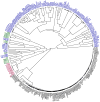The pharmacological landscape and therapeutic potential of serine hydrolases
- PMID: 22212679
- PMCID: PMC3665514
- DOI: 10.1038/nrd3620
The pharmacological landscape and therapeutic potential of serine hydrolases
Abstract
Serine hydrolases perform crucial roles in many biological processes, and several of these enzymes are targets of approved drugs for indications such as type 2 diabetes, Alzheimer's disease and infectious diseases. Despite this, most of the human serine hydrolases (of which there are more than 200) remain poorly characterized with respect to their physiological substrates and functions, and the vast majority lack selective, in vivo-active inhibitors. Here, we review the current state of pharmacology for mammalian serine hydrolases, including marketed drugs, compounds that are under clinical investigation and selective inhibitors emerging from academic probe development efforts. We also highlight recent methodological advances that have accelerated the rate of inhibitor discovery and optimization for serine hydrolases, which we anticipate will aid in their biological characterization and, in some cases, therapeutic validation.
Figures




References
-
- Davie EW, Ratnoff OD. Waterfall Sequence for Intrinsic Blood Clotting. Science. 1964;145:1310–2. - PubMed
-
- Whitcomb DC, Lowe ME. Human pancreatic digestive enzymes. Dig Dis Sci. 2007;52 :1–17. - PubMed
-
- Lane RM, Potkin SG, Enz A. Targeting acetylcholinesterase and butyrylcholinesterase in dementia. Int J Neuropsychopharmacol. 2006;9:101–24. - PubMed
-
- Bonventre JV, et al. Reduced fertility and postischaemic brain injury in mice deficient in cytosolic phospholipase A2. Nature. 1997;390:622–5. - PubMed
-
- Menendez JA, Lupu R. Fatty acid synthase and the lipogenic phenotype in cancer pathogenesis. Nat Rev Cancer. 2007;7:763–77. - PubMed
Publication types
MeSH terms
Substances
Grants and funding
- CA087660/CA/NCI NIH HHS/United States
- R37 CA087660/CA/NCI NIH HHS/United States
- GM090294/GM/NIGMS NIH HHS/United States
- R01 DA025285/DA/NIDA NIH HHS/United States
- DA025285/DA/NIDA NIH HHS/United States
- R01 CA132630/CA/NCI NIH HHS/United States
- R01 GM090294/GM/NIGMS NIH HHS/United States
- DA009789/DA/NIDA NIH HHS/United States
- P01 DA009789/DA/NIDA NIH HHS/United States
- P01 DA017259/DA/NIDA NIH HHS/United States
- R01 CA087660/CA/NCI NIH HHS/United States
- CA132630/CA/NCI NIH HHS/United States
- DA017259/DA/NIDA NIH HHS/United States
LinkOut - more resources
Full Text Sources
Other Literature Sources

